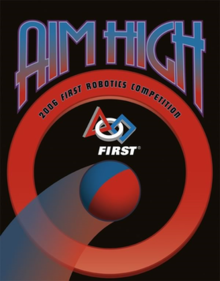2007 Game: Rack n’ Roll
Robot Name: V2
In honor of: Bill Vinnage

Field
The Rack ‘n Roll field is dominated by ‘The Rack’, a large metal contraption with three levels of hanging metal bars, with each level having 8 arms evenly spaced in an octagonal manner. Each arm (also known as a ‘spider leg’) has space for two game pieces. Any more pieces placed on a spider leg beyond the first two are ignored for scoring purposes. At the beginning of the match, the rack is arbitrarily translated or rotated within three feet of the center of the field in order to give some randomness and to encourage autonomous modes that do not depend on dead-reckoning. At the top of the Rack are four green-colored lights above the 1, 3, 5, and 7 legs to aid in autonomous-mode tracking.
The game is made up of two scoring periods. The ï¬rst 15 seconds of play is the Hybrid period in which robots are autonomous, and may also respond to certain digital signals sent by team members designated as “Robocoaches”, who are stationed at the corners of the track.
The next two minutes of play is the Teleoperated period. At this time, robots are fully radio controlled by the team operators standing at either end of the ï¬eld.
Scoring
Rack Scoring
The primary method of scoring in Rack ‘n Roll is by making rows and columns of tubes on the rack. A row or column of n tubes is worth 2n points to a maximum of n=8. Note that this includes rows or columns of length 1, so a single tube on the rack that does not form a row or column is worth 2 points. Teams have access to 21 scorable keepers and ringers. This means that the maximum possible score from the rack should be 596 . That is, two rows of 8 ringers, a row of 5 (2 ringers plus 3 keepers), 5 vertical columns of length 3, then 3 vertical columns of length 2.
 Robot Scoring
Robot Scoring
Robot positions at the end of the match are worth bonus points. In Rack n’ Roll, each robot in its alliance end zone that is not touching any field element and has its lowest part 4 or more inches off the ground will score 15 bonus points. A robot that is not touching any field element and has its lowest part 12 or more inches off the ground will score 30 bonus points. Since robots may not be touching any field element, this means that in order to score bonus points, teams will have to depend on their alliance partners to provide mechanisms to lift their robots or will have to have mechanisms to lift their alliance partner’s robots. Since at least one robot must be touching the ground in order to lift the other two alliance robots off the ground, the maximum conceivable bonus points an alliance can score is 60 points.
Game Play/Pieces
The game pieces in Rack ‘n Roll are inflatable toroidal pool toys. There are 3 styles: Keepers, Ringers, and Spoilers. Keepers are tubes with lettering that are placed only during autonomous mode and, once placed, override any pieces placed later for scoring purposes. Ringers are undecorated tubes that are delivered onto the field either by human players via chutes, or are picked from the floor. Nine ringers of each color start on the field in the opposing team’s start area (so the 9 blue ringers are in the red alliance’s end zone, and vice versa). The other nine start behind the end wall, to be given out by human players. Spoilers are colored black, and cause the spider arm holding them to be ignored for scoring purposes. Spoilers can be removed or repositioned on the rack by robots multiple times. Each alliance starts with two spoilers, accessible by their human players.
Each match of Rack ‘n Roll is 2 minutes 15 seconds long, divided into three segments. The first segment is a 15 second autonomous period, where robots may attempt to place keepers onto the rack without human input. Once autonomous mode is complete, any keepers not already on the rack are no longer valid for scoring. The second segment, the teleoperated mode, is 2 minutes long, during which robots are operated by the drivers and may roam anywhere on the field. In the final 15 seconds, the end game, robots may not enter their opponent’s end zone, but all other rules remain the same from the teleoperated period. Though the head referee may pause the game between the autonomous period and the teleoperated period, the end game follows directly after the teleoperated period.

















 Robot Scoring
Robot Scoring


